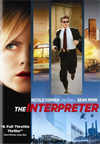The Interpreter
Universal Home Video
Cast: Sean Penn, Nicole Kidman, Catherine Keener, Jesper Christensen, Yvan Attal
Extras: Commentary Track, Behind-the-Scenes, Featurettes, Deleted Scenes, Alternate Ending
Rating:
This might sound strange, but if I am watching a film and I never get the urge to look at my watch or glance at the DVD players counter display, thinking to myself, "good god how long is this?" that simple act alone tells me that I am watching a truly well made film, which is exactly how I could describe my experience while viewing "The Interpreter".
Offering up everything most of us look for in a film, most of the time, "The Interpreter" implemented a terrific execution of a well written story, told in a nice even flow that was complimented with great casting that included Sean Penn turning in yet another solid performance.
Revolving around a United Nations interpreter named Silvia Broome (Nicole Kidman) who mistakenly overhears a potential death threat towards an African head of state, late one night in the general assembly auditorium. Silvia manages to escape unharmed, but her world is eventually turned upside down as she discovers that she has become a target herself. Gaining the protection of federal agent Tobin Keller (Sean Penn), Silvia's identity comes more and more into question as various situations arise that cause Keller to wonder if Silvia is an innocent victim, or if she is involved in the assignation plot as well. Loaded with some great suspense filled scenes that will easily grab your attention, "The Interpreter" is one taut political thriller that you won't soon forget. A nice touch to the film is the inclusion an un-credited small part featuring Sydney Pollack himself.
Universal Home Entertainment delivers an impeccable anamorphic transfer of "The Interpreter" that did not exhibit any visible blemishes in the form of dust elements or compression artifacts. Colors were well saturated to provide natural appearing flesh tones, with the odd exception of Kidman, who appeared rather pale at times. The color detail was nicely highlighted throughout the film from the pink blossoms on the trees in a nearby park, to the rich woods used in the interior of the United Nations. Blacks were rich and deep in reproduction, which managed to provide spectacular detail during aerial shots of the Manhattan skyline.
The soundtrack is offered in a Dolby Digital 5.1 mix that displayed naturally appearing vocals within the presentation. While all channels were utilized throughout the film, the main focus of the soundtrack was placed in the front, taking full advantage of the lower frequency .1 channel during tension filled scenes that offered good deep bass.
For viewers looking for a little more after the films feature presentation, there are a few surprises waiting in the special features section. Included is a full-length audio commentary from director Sydney Pollack that can be accessed through the audio selection menu or the special features section. Also available is an alternate ending and a brief deleted scenes section that is worth looking into. "The Ultimate Movie Set: The United Nations" features a discussion on the subject of how "The Interpreter" became the first and only film to have ever been filmed in the United Nations building. Director Sydney Pollack talks of his frustrations after being denied any access to the United Nations, only eight weeks before production was to begin! It eventually took a personal meeting with Secretary-General Kofi Annan, who then determined that this was indeed a quality production that would showcase the United Nations in a rather positive light, in turn granting Pollack full approval to proceed with filming.
One of the coolest extra features that I have seen on DVD to date, is this featurette titled "Interpreting Pan & Scan vs. Widescreen", where director Sydney Pollack talks about his love of the widescreen format, yet how he chose to abandon widescreen in favor of the full frame ratio some twenty years earlier. His decision was solely based on the butchering of Hollywood films for network television presentation that only leads to the director's original vision being completely lost in the process when a widescreen film is panned and scanned. Taking place in an actual editing room, Pollack delves into details of how the widescreen format allows filmmaker's to tell more of the story in a shorter time frame and gives the example of presenting a "sense of place" with a close-up shot while still allowing action to continue on the sides or in the background of a particular frame. Ironically, Pollack's first film that he shot for an eventual full frame presentation was the Oscar winning "Out of Africa", which would have easily benefited from a true widescreen presentation. Finally after two decades, Pollack returns to the full scope of widescreen with "The Interpreter", presented in a gorgeous 2.35:1 aspect ratio. Talk about being totally dedicated to your art!
Also included is the interesting "A Day in the Life of a Real Interpreter", which features interviews with actual United Nations interpreters. Here you will get a brief, but educational look into what makes a successful interpreter and learn the vast differences between basic translating and a full interpretation between different languages.
I was totally under the impression that I was in for the usual run-of-the-mill political yarn that would offer up all of the basics, instead I was treated to a truly well made film with some great special features.







